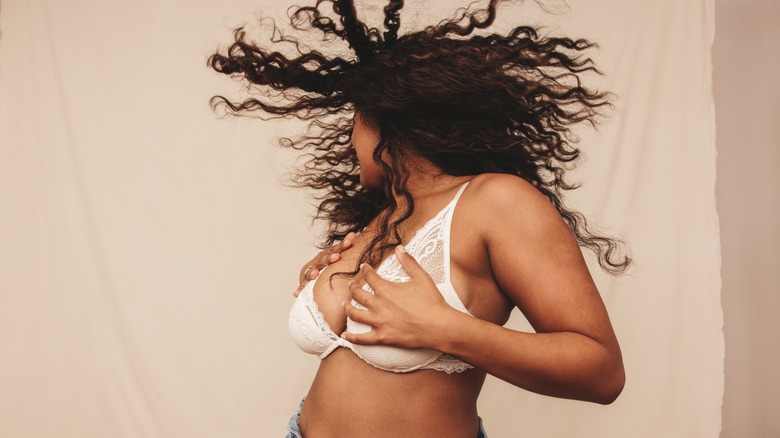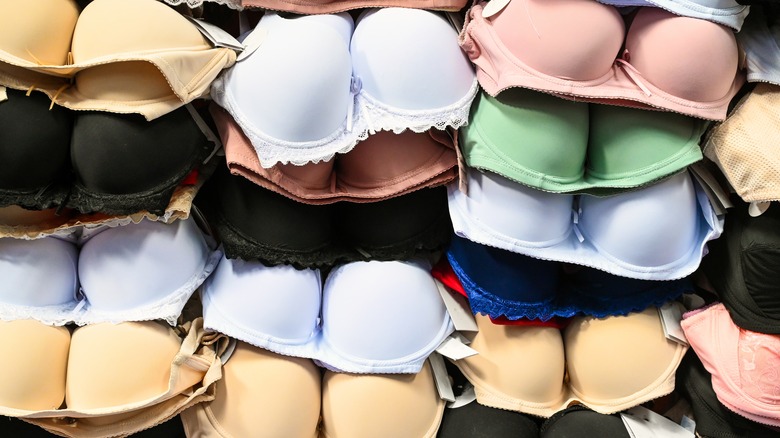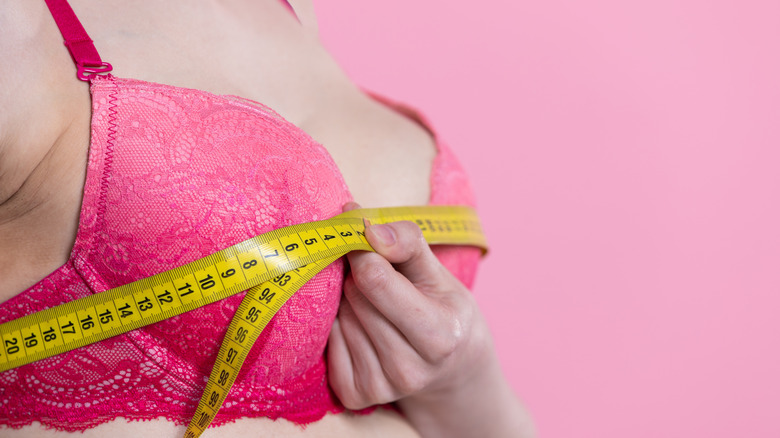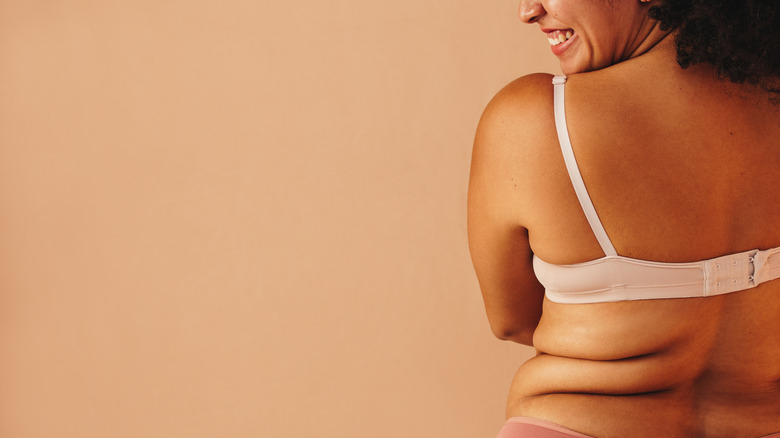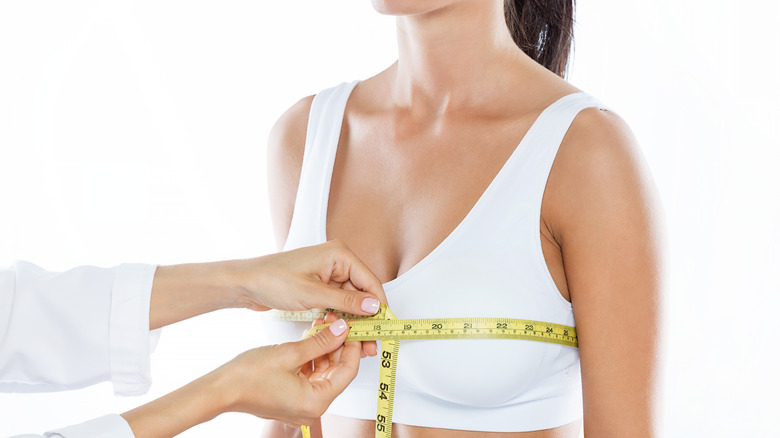Your Guide To Sister Sizes For Bras
Bras can be such a blessing, but also a bit of a curse. For one, there are so many cute patterns and styles of bras that it's a lot of fun shopping around for them. Even for people who wear larger bra sizes, the market has gotten a bit better at having adorable and sexy options with inclusive sizing (they're still not fully there yet, but they're getting there). It can be a curse, though, because they can be uncomfortable, and it's also such a pain to figure out sizes. Well, sister sizes in bras might be the saving grace you need when it comes to bra shopping.
You may have heard of sister bra sizes, and they could be the answer to your uncomfortable lingerie problem or help you find a sold-out bra in a size — different from your regular one — that will still fit you.
A sister size can help you go up in a bra band size (or down if you're feeling like you need a bit tighter fit) while keeping your cup volume the same. Here's a guide on how to find your sister size in bras and what that even means.
What is a 'sister size' bra size?
We all have our go-to bra size. But if you're ever in a situation where you need to move up a band size or down one, but your breast size hasn't really changed, a sister size can help figure that out. Theoretically, a sister size is a bra size that you can fit into even if it's not technically "your size."
A sister size in bras is for when you need to move up or down in the band, but keep the cup volume the same. When looking at a bra size, you have a number and a letter. The number is your band size, or the width of your torso that your bra band needs to fit. If you ever find your bra band digging into your back or sides, it might be because your band size needs to be bigger. If your breast size has stayed the same, you can look into your sister size.
The letter in a bra size is the size of the cup. When contrasted with your band size, this illustrates the volume of your breast. Even if you need to go up or down in your band size, the volume of your breast might stay the same. To put it simply, a sister size allows you to move between band sizes without getting a bra that has a cup too big or too small for your breasts.
A sister bra size might fit better or open up your options
When would you need to find a sister size in bras? As stated above, knowing your sister size is a great way to quickly and easily figure out what bra might fit you if you need to move up or down in your band size.
Maybe you've lost weight and your bras are slightly loose, not providing the same support as before. Or maybe your bras are digging in more than usual and you realize you need to fix that problem once and for all. Trying out a sister size can help you find a band that fits while not changing your cup volume.
Sister sizes are also very helpful when you can't find your size bra in a shop or online. If you really want a bra in a specific style or pattern, you can buy it in your sister size if they have it. If you're using your sister bra size for this reason, the band will end up being a bit too tight or too loose, as PureWow reported, but it'll usually be manageable.
Finding your sister size is simple
Again, not all cups are created equal. A 34B won't fit a 36B or 38B. As SizeChart.com reported, one cup letter is not going to be the same volume as the same letter and a different band. Not all A's are the same size, and so on. They write that cup sizes are "relative to bra band size," meaning that someone who wears a 32DD is not going to have a bra with the same size cup as a 40DD.
That's why bra size charts often look like a mountain; the higher up you go in a band, you go down in the cup size to stay with the volume of your breast. So in order to figure out what your sister size is, you can either use a chart or do the "bra math." Victoria's Secret and SizeChart.com have nifty tables or illustrations to help you find your sister bra size, for instance.
But if you want to do the math yourself to figure it out on your own for any size, it's not hard at all. If you'd like to go up in sister sizes, you go up a band size and down a cup size. So a 36D would become a 38C.
When you'd like to go down a sister size, you'd do the opposite, meaning you'd go down a band size but go up a cup size. So a 36D would become a 34DD.
Sister bra sizes are sisters, not twins
Again, sister sizes are great tools if your bras are running looser or tighter than normal and you want to see what size options you have without having to get remeasured. Sometimes they might even fit you better. Bra measurements are tricky and a lot of people wear the wrong bra size on a regular basis. More on how to find the perfect bra size in a minute.
Sister sizes can really help to alleviate issues that come up if you find your bands are constantly digging into you, for example. However, sister sizes aren't a cure-all. If you're buying a sister size because your regular size is sold out somewhere, remember that it's called a "sister size" and not a "twin size" for a reason.
The sister size could either be too big or too small or fit in a way that you're not used to and don't like. If you're trying to find a bra that fits better than your typical size, you might just need to get remeasured to fix your issues.
Sister sizes might not help; you might need to remeasure
If you try out a sister size to fix any band or cup issues you're experiencing, and it doesn't help, you probably need to remeasure yourself. Starting from square one and finding out what the measurements say about your bra size is always a good solution.
As PureWow writes, use a tape measure to "determine the circumference of your rib cage," meaning: measure under your breasts in the area where a band would go. Take that number (round to the nearest even number) and that's your band size. According to a TikTok hack from user @pepperonimuffin, it's better to measure your band as tight as possible and round up, per HuffPost UK. This gives a more accurate size for your bra.
For your cup size, you need to do a bit more math. Take the measuring tape and measure the "fullest part of your chest" and round up to the nearest whole number. Take that number and subtract your band number; the difference between the two numbers is your cup size. "One inch would be an A cup, two a B cup, three a C cup, and so on," PureWow writes. If they're equal, that's an AA cup.
For example, if your bust size is 32 and your band size is 30, your bra size would be 30B. If you don't want to do the math, online calculators are available to make the process easier.
Hopefully, between finding your sister size or remeasuring your bra size, you can fix any bra sizing issues you have and go on wearing your cute and sexy — or cute and comfortable — bras to your heart's content.
